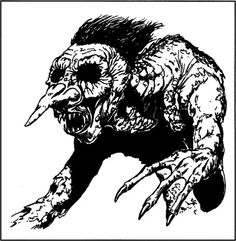Session 19C: Shilukar’s End
Last week we talked about players creating a firewall between player knowledge and character knowledge. This week I want to talk about some of the pitfalls in doing that.
Think back to when you first started playing D&D. If you’re lucky, then you’ll remember the time that your DM described a huge, hulking, green-skinned humanoid. You chopped at it with your sword! A mighty blow! But the wound begins closing up right in front of your eyes! Nothing will slay the thing! Run away!
 The creature was, of course, a troll. And you eventually figured out that the only way to permanently injure it (and eventually kill it) was by dealing damage with fire. Think about how exciting it was to figure that out!
The creature was, of course, a troll. And you eventually figured out that the only way to permanently injure it (and eventually kill it) was by dealing damage with fire. Think about how exciting it was to figure that out!
There are countless other examples of this hard-won knowledge that you have probably accumulated over the years. And not all of it is as clear-cut or specific as this. It includes stuff like “always bring a 10-foot-pole” and even “put the squishy wizard in the back.”
Now, here’s the question: Having learned all that stuff, you’re starting a new campaign with a brand new 1st level character.
Should your 1st level character know that trolls are vulnerable to fire?
It turns out that what seems like a simple question isn’t.
Let’s start by acknowledging the elephant in the room: You can’t actually put the genie back in the bottle. Once you know that trolls can’t regenerate from fire damage, you can’t “unlearn” that and truly play as if you don’t know it in order to rediscover it.
I knew a group once that mimicked that experience by randomizing the vulnerability of trolls at the beginning of each campaign. But even that isn’t truly a complete reset of your knowledge because you’re still carrying the knowledge that trolls can regenerate and you need to play “guess the element” to truly injure them. Even just the knowledge that some things in the game are immune to damage except from certain sources is knowledge that you had to learn as a player at some point!
The argument can be made that, since the character actually lives in a world with trolls, it might make sense that they know that trolls are vulnerable to fire even if they haven’t personally fought a troll before. Maybe you could make an Intelligence check to see if they know it or not.
… but if you do that, why didn’t the DM have you roll a Knowledge check for your first character?
The answer, of course, is that it’s fun to be surprised by the unknown, to recognize that there’s a problem that needs solving, and to figure out the solution. And it’s generally not fun to simply roll a Solve Puzzle skill and have the DM tell you the answer.
Nonetheless, there’s a good point here: Assuming that characters who have spent their entire lives within walking distance of the Troll Fens don’t know anything about trolls is, quite possibly, an even larger metagame conceit than “my peasant farmboy has memorized the Monster Manual.”
But for the sake argument, let’s say that “trolls are vulnerable to fire” is, in this particular D&D universe, not a well known fact.
Another argument that can be made, therefore, is that you simply need to roleplay the character not knowing the thing that you, as a player, know.
In my experience, however, this approach usually takes the form of indicating that the character doesn’t know it, which often does not actually look like someone who doesn’t actually know it.
You often see a similar example of this when players have metagame knowledge of what’s happening to other PCs and begin explaining, out of character, the thought process of their character so that the other players don’t think they’re cheating by using the metagame knowledge. This, too, often does not resemble actual decisions made by someone who doesn’t actually know the information: It, in fact, looks exactly like someone pretending that they don’t know the solution to a problem even when they do. Like a parent playing hide-and-seek with a toddler and pretending that they can’t find them even though their feet are poking out from behind the chair.
I once played in a game where some shit was going down in our hotel room and I said, “Okay, I finish my drink in the hotel bar and head back up to the room.” And the GM immediately pitched a fit because I was using metagame knowledge. I had to point out that, no, I had already established that I was going to finish my drink and head back up to the room before shit started going down. Nevertheless, there was an expectation that my character should instead NOT do what they had already been planning to do because there was an expectation that we should go through a charade or pantomime in which my character would do a bunch of other stuff in order to indicate what a good little player I was by not acting on the metagame knowledge.
WHAT IS FUN?
This is not to say, of course, that players should freely act on metagame knowledge. The issue is more complicated than that, and largely boils down to personal preference and a basic question of, What is fun?
Is it fun to pretend to re-learn the basic skills of dungeoncrawling? Generally not, IME. That’s the Gamist streak in me: Problem solving for the best dungeoncrawl techniques is fun because I’m figuring out how to overcome a challenge; it’s not fun for me to simply pretend to be challenged by that stuff. I’d rather focus on the next level of challenge. (And, if the GM is a good one, there’ll be a constant fresh supply of new, non-arbitrary challenges as we move from one dungeon to the next.)
Is it fun for players to act on metagame knowledge and all rush towards where something interesting or dangerous is happening as if they were gifted with a sixth sense? Or to instantly know when another PC is lying or holding information back? Generally not. That’s the Dramatist streak in me, and if I’m GMing a group that’s having problems refraining from these actions OR roleplaying naturally despite possessing metagame knowledge, I’ll start pulling players into private side-sessions in order to resolve these moments. (Because if I don’t, valuable and cool moments of game play will be lost.)
(Over the years I’ve also come to recognize that the possession of certain types of metagame knowledge are, in fact, virtually impossible to roleplay naturally through. And I will use techniques — including private side sessions and non-simultaneous resolution — to control the flow of metagame information to best effect.)
These lines, however, are not set in stone. They’re very contextual. If we’re playing a typical dungeoncrawl I generally don’t think “let’s all pretend we don’t know that 10-foot poles would be useful” is fun. On the other hand, if I’m playing Call of Cthulhu I’m totally onboard with stuff like “let’s all pretend we don’t recognize the name Nyarlathotep” or “let’s all pretend that we don’t know what a Hound of Tindalos is.”


 The creature was, of course, a troll. And you eventually figured out that the only way to permanently injure it (and eventually kill it) was by dealing damage with fire. Think about how exciting it was to figure that out!
The creature was, of course, a troll. And you eventually figured out that the only way to permanently injure it (and eventually kill it) was by dealing damage with fire. Think about how exciting it was to figure that out!










